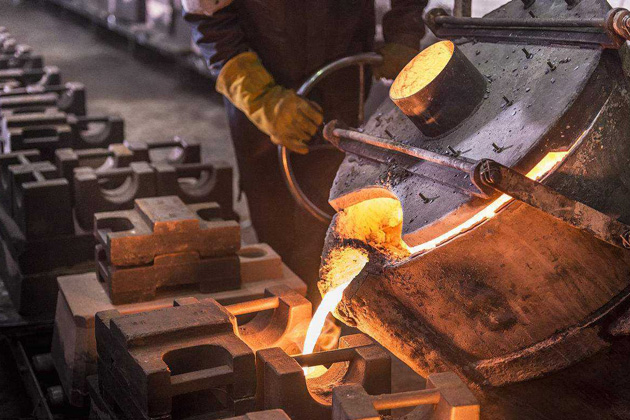Just How Aluminum Foundry Adds To Improvements in Aerospace Design
Aluminum factories are important to advancements in aerospace design. They create light-weight, high-strength elements that are essential for modern aircraft. Through innovative casting strategies, these foundries develop complex geometries that improve structural stability. Furthermore, the advancement of exceptional Aluminum alloys supports the market's concentrate on gas effectiveness and sustainability. Nevertheless, challenges remain in the production process. Recognizing these aspects discloses the extensive impact of Aluminum on aeronautics's future.
The Value of Lightweight Products in Aerospace Style
As the aerospace sector remains to advance, the importance of light-weight materials comes to be significantly apparent. The demand for efficiency and sustainability drives engineers to focus on the use of materials that lower general weight without jeopardizing structural integrity. Light-weight materials, specifically Aluminum, play an important function in enhancing gas effectiveness, boosting haul ability, and increasing the overall performance of airplane.
The combination of these materials allows for innovative styles, enabling suppliers to produce even more wind resistant forms that can hold up against severe problems. The decrease in weight not only reduces operational expenses however additionally adds to a lowered ecological footprint, lining up with international efforts towards sustainability in air travel.
Advanced Spreading Techniques in Aluminum Foundries
Advanced casting techniques in Aluminum foundries play an important role in aerospace engineering by making it possible for the production of light-weight and exact components. Advancements in mold style and accuracy spreading processes are necessary in attaining ideal performance and structural integrity. In addition, the development of light-weight alloys boosts the general effectiveness and effectiveness of aerospace applications.
Innovative Mold And Mildew Layout
Innovative mold design plays an important role in the effectiveness and effectiveness of Aluminum foundries, particularly within the aerospace market. By leveraging innovative materials and methods, modern molds can be engineered to endure heats and pressures, ensuring peak efficiency throughout the spreading procedure. These layouts frequently integrate complicated geometries that permit for the production of light-weight yet structurally audio elements, crucial for aerospace applications. Additionally, making use of computer-aided design (CAD) software program facilitates exact modeling, allowing foundries to fine-tune and mimic mold and mildew designs before physical production begins. This not only boosts the high quality of actors components yet likewise decreases waste and lead times, leading to significant expense savings. On the whole, cutting-edge mold and mildew style is a cornerstone of progress in Aluminum Foundry innovation for aerospace engineering.
Precision Casting Procedures
The performance of ingenious mold styles flawlessly integrates with accuracy spreading processes, which are necessary for generating premium Aluminum elements in aerospace design. These procedures, including sand casting, die spreading, and investment spreading, guarantee the creation of intricate geometries with tight resistances. Advanced strategies like vacuum cleaner casting and stress die casting improve the integrity and surface finish of the end products. Accuracy casting decreases material waste while optimizing the mechanical properties of Aluminum, important for aerospace applications. On top of that, using real-time monitoring and progressed simulation tools during the spreading process allows for immediate adjustments, leading to improved quality assurance. Jointly, these precision casting processes placement Aluminum foundries at the leading edge of aerospace advancement, supporting the market's need for integrity and performance.
Lightweight Alloy Development
As aerospace engineers look for to boost fuel performance and efficiency, lightweight alloy growth becomes a necessary emphasis in Aluminum foundries. These shops employ innovative casting methods to develop alloys that supply exceptional strength-to-weight proportions. Advancements in alloy make-up, consisting of the consolidation of elements like lithium and magnesium, make it possible for the production of products that endure severe conditions while decreasing total aircraft weight. Methods such as die casting and investment casting facilitate the precision production of intricate shapes, which are vital for aerospace applications. In addition, continuous research intends to enhance these alloys for enhanced mechanical properties and enhanced sturdiness. By prioritizing lightweight alloy growth, Aluminum factories considerably add to the development of aerospace engineering, leading the way for extra lasting and reliable airplane designs.

Enhancing Structural Honesty With Aluminum Parts
Aluminum parts offer substantial advantages in improving structural integrity within aerospace engineering. Their light-weight nature adds to general effectiveness while maintaining stamina, which is essential for aircraft performance. In addition, the stress resistance homes of Aluminum assistance assure the sturdiness and integrity of aerospace structures under different functional conditions.
Lightweight Product Perks
While conventional products frequently endanger weight for strength, using Aluminum elements in aerospace engineering offers considerable advantages in architectural integrity. Aluminum's light-weight nature adds to total style effectiveness, permitting for more structured airplane that eat less fuel, therefore enhancing sustainability. The material's outstanding strength-to-weight proportion guarantees that parts keep toughness without adding unneeded mass. This top quality promotes improved performance and agility in flight, in addition to optimized haul abilities. Additionally, Aluminum's resistance to deterioration lengthens the life expectancy of aerospace frameworks, lowering upkeep expenses and enhancing safety and security. As makers progressively embrace Aluminum alloys, the aerospace sector experiences a transformative change towards extra reliable and effective design services that prioritize both performance and environmental duty.
Tension Resistance Qualities
Although different materials possess one-of-a-kind buildings, Aluminum's remarkable stress and anxiety resistance attracts attention as an essential consider improving the architectural stability of aerospace elements. This resistance plays a vital duty in making sure that aircraft can withstand numerous functional tensions, including fatigue, influence, and ecological problems. Aluminum alloys, especially engineered for aerospace applications, display high tensile toughness while keeping light-weight features, enabling designers to develop much more reliable frameworks - Aluminum Foundry. Additionally, the capacity of Aluminum to withstand cyclic loading without considerable deformation adds to the longevity and reliability of aerospace elements. As developments continue in Aluminum Foundry strategies, the development of stress-resistant Aluminum parts assures further improvements in efficiency, safety, and efficiency across the aerospace market, strengthening Aluminum's role as a favored product in contemporary engineering
Fuel Effectiveness Improvements Driven by Aluminum Innovations
As the aerospace market seeks to enhance fuel performance, cutting-edge usages of Aluminum have become an essential solution. Aluminum's lightweight nature significantly decreases aircraft weight, allowing for lower gas usage throughout trip. This decrease in weight is essential, as also little reductions can bring about substantial enhancements in overall gas economic climate.
Advanced Aluminum alloys, made for enhanced strength and resilience, make it possible for manufacturers to develop elements that keep architectural integrity while reducing mass - Aluminum Foundry. In addition, the combination of Aluminum in airframes and engine elements helps with improved the rules of aerodynamics, adding to minimized drag and enhanced effectiveness
The fostering of Aluminum in aerospace not only fulfills the need for fuel-efficient layout but likewise aligns with regulative stress for lower discharges. As these innovations proceed to progress, they play go to the website a considerable duty in setting brand-new standards for gas effectiveness, guaranteeing that the aerospace sector can fulfill expanding ecological and financial challenges.

The Role of Aluminum in Sustainable Aeronautics Practices
The enhancing focus on sustainable aeronautics techniques has positioned Aluminum as a crucial product in the quest for greener airplane style. Known for its lightweight residential properties, Aluminum significantly reduces airplane weight, resulting in lower gas consumption and emissions. Its recyclability even more enhances its sustainability account, as Aluminum can be reused forever without loss of quality. This characteristic sustains a round economic situation within the air travel market, lessening waste and source depletion.
Additionally, innovations in Aluminum alloys have improved their stamina and deterioration resistance, permitting for longer life span and lowered upkeep needs. These developments facilitate the growth of a lot more effective airplane structures, adding to general sustainability initiatives. Furthermore, Aluminum's thermal conductivity plays a critical function in energy-efficient designs, improving systems such as warmth exchangers. Collectively, these attributes emphasize Aluminum's pivotal function in progressing sustainable aviation, straightening with worldwide initiatives targeted at minimizing the environmental impact of flight.
Difficulties Dealt With by Aluminum Foundries in Aerospace Manufacturing
While Aluminum foundries play a crucial function in aerospace manufacturing, they face substantial obstacles that can influence manufacturing effectiveness and top quality. One significant obstacle is the stringent top quality control requirements called for in the aerospace sector. Any flaw can compromise safety and performance, necessitating strenuous evaluation processes that extend manufacturing timelines. In addition, factories frequently contend with rising and fall resources expenses, which can influence prices and earnings. The complexity of Aluminum alloys made use of in aerospace applications additional makes complex the manufacturing process, as accurate formulations are essential for achieving wanted mechanical residential properties. Furthermore, experienced labor lacks hinder the capability to preserve top quality manufacturing degrees. Ecological policies impose limitations on discharges and waste monitoring, needing factories to invest in lasting practices, which can be cost-prohibitive. These factors jointly create a landscape where Aluminum factories must constantly adjust to meet the evolving needs of aerospace manufacturing while making sure safety and compliance.
Future Trends in Aluminum Applications for Aerospace Design
With developments in innovation and enhancing needs for effectiveness, the future of Aluminum applications in aerospace design is positioned for substantial transformation. The assimilation of ingenious Aluminum alloys and composites is expected to improve strength-to-weight ratios, bring about more fuel-efficient airplane styles. Additionally, improvements in additive production strategies will permit the manufacturing you could try here of intricate Aluminum frameworks that were previously difficult, maximizing efficiency and minimizing waste.

Lasting techniques will certainly play a vital duty, with an expanding focus on reusing Aluminum to reduce environmental influence. The aerospace sector is most likely to embrace smarter making processes, such as automation and expert system, making certain greater high quality and accuracy in Aluminum components. Collaborations between Aluminum factories and aerospace firms will promote research and development, leading the method for brand-new applications that fulfill the rigorous demands of modern aerospace design. Generally, the future looks guaranteeing for Aluminum's duty fit the skies
Frequently Asked Concerns
What Are the Ecological Effects of Aluminum Manufacturing in Aerospace?
The ecological impacts of Aluminum production in aerospace include substantial energy consumption, greenhouse gas discharges, and environment disruption. Additionally, mining processes can lead to dirt deterioration and water contamination, increasing problems about sustainability and eco-friendly balance.
Exactly How Does Aluminum Compare to Other Products in Aerospace Applications?
Aluminum provides a special combination of lightweight homes, rust resistance, and cost-effectiveness compared to various other products. Its high strength-to-weight ratio makes it especially beneficial for aerospace applications, enhancing fuel effectiveness and total performance in airplane design.
What Credentials Do Aluminum Foundry Employees Need for Aerospace Projects?
Aluminum Foundry workers require specialized training in metallurgy and spreading methods, along with understanding of aerospace market requirements. Accreditations in quality assurance and safety methods are likewise important to guarantee conformity with rigid aerospace project needs.
Are There Any Type Of Security Worries With Making Use Of Aluminum in Aerospace Engineering?
Safety concerns relating to Aluminum in aerospace design consist of susceptibility to tension, fatigue, and deterioration fractures. Proper treatment and alloy choice are vital to reduce these dangers, making certain architectural stability and total safety and security in aerospace applications.
Just How Does Aluminum Recycling Advantage the Aerospace Industry?
Aluminum recycling considerably profits the aerospace sector by lowering material expenses, decreasing ecological influence, and conserving power. This lasting practice boosts the sector's efficiency while promoting making use of light-weight, high-performance components in aircraft production.
Advanced spreading techniques in Aluminum factories play a vital function in aerospace design by allowing the manufacturing of light-weight and exact parts. Innovative mold layout plays an essential role in the performance and effectiveness of Aluminum foundries, particularly within the aerospace industry. As aerospace engineers seek to improve fuel efficiency and efficiency, lightweight alloy advancement becomes an important focus in Aluminum foundries. Aluminum alloys, especially engineered for aerospace applications, show high tensile strength while keeping light-weight characteristics, enabling engineers to develop more effective frameworks. Partnerships in between Aluminum shops and aerospace firms will promote research study and development, leading the next page way for new applications that fulfill the rigid demands of modern aerospace engineering.